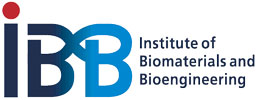Core Concepts
Convergence of Semiconductor Technologies, Life Science and Medicine
There has been a rapid progress in our ability to control matters of nanoscales and even molecules. Advancement of nanotechnology continuously hastens integrations of different disciplines of engineering and medicine beyond the conventional specialties. "Biotransistors" is a form of biosensors that can readily be downsized and fabricated in highly integrated modalities by virtue of the current advanced semiconductor fabrication technology. A direct signal conversion from molecular charges to electrical readout is an important capability of the biotransistors, making it a remarkably simplified platform for quantitative analysis of biology. In terms of scalability, it is downsizable in theory to the level of molecules, unlike any optics-based methods that must suffer from diffraction limit of light, which lies on the order of several hundred nanometers. With these advantages, biotransistors offer an attractive option to realize home healthcare and diagnosis by providing miniaturized and easy-to-operate type of biosensors. In the current pharmaceutical and cosmetics industries, there is a growing concern and regulation in the scale of animal studies not only for economic reasons but also in light of animal welfare and, therefore, we are facing an urgent demand for alternative methodologies. In this regard, screening formats that are compatible with cultured cells are likely to prevail for the coming decades. For the purpose of screening studies, it is always desired to reduce the amount of candidate drugs and compounds, which are oftentimes very precious and expensive. We have already demonstrated unique devices so-called "cell-transistors" that combine functions of semiconductors and cells, which may have a potential to address all the aforementioned criteria. In the field of tissue engineering, it is critically important to secure safety and quality of cells and tissues prior to implantations on a highly parallel basis. In addition, these assessments need to be done in a minimally invasive manner to autologous tissues of the patients. Cell-transistors with its non-invasive nature may provide a solution. Biotransistors, devices that can detect charge-density-changes in the vicinity of its gate insulator surface, have also been applied for kinetic analysis of membrane proteins or transporters and even differentiation processes of cells. Therefore, these techniques may help us to obtain new insights into cells and more fundamental biology. Biotransistors related research is truly interdisciplinary; it involves micro-/nano-fabrication technologies, solid-state physics, electro-/surface- chemistries, control of specific bio-recognitions, and so on. We pursue this area and hopefully pave the way for new principle of science and industry.
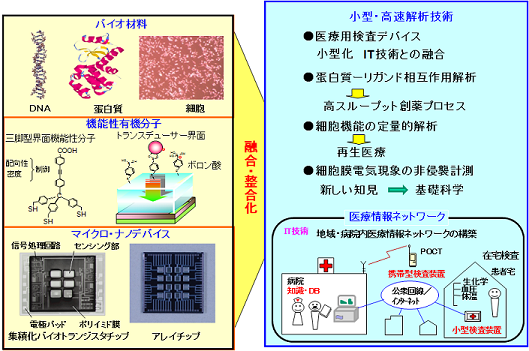
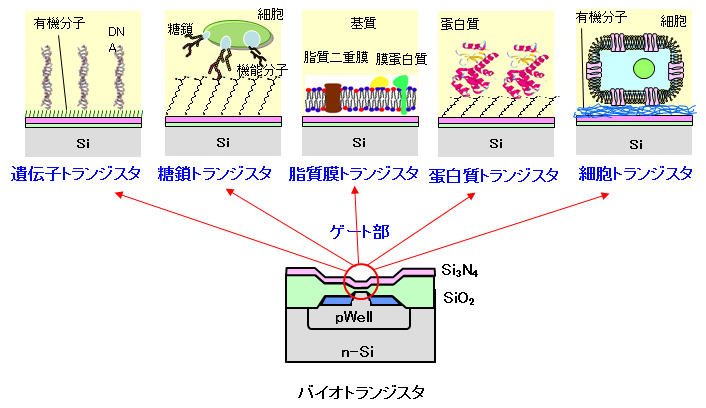
Research Topics
Development of a Self-Regulated Insulin Delivery System -A Totally Synthetic Artificial Pancreas-
Diabetes is not an infectious disease but its increasingly rapid and worldwide prevalence has been recognized as "pandemic". Despite the necessity for continuous and accurate glycemic control in the management of insulin dependent diabetes mellitus, the current palliative treatment relies almost solely on the patient-self injection of insulin, which not only impinges on quality of life of the patients but also fails to precisely control dose of insulin where the overdose must be strictly avoided otherwise causing serious hypoglycemia. Development of self-regulated insulin delivery systems is a long-standing challenge of materials science, for which exploitations of glucose oxidase and sugar-binding lectin are two prevalent strategies to install the function of glucose-sensitivity. These protein-based components, however, intolerant of long-term use and storage with their denaturing and cytotoxic natures, are hardly suitable for any implantable applications thus have not yet been in clinical usage to date. Here we describe a thoroughly synthetic and remarkably simple alternative. A polymer gel bearing phenylboronic acid derivative was chemically optimized as to elicit an abrupt and glucose-dependent transition in the state of hydration under physiological aqueous condition. During this transition, development of a thinly surface-dehydrated layer or "skin layer" was identified as a mode that is able to discretely switch the release of gel-loaded insulin, providing an ability to synchronize the dosage with the surrounding glucose-fluctuation in the range between normo- and hyperglycemia. This synthetic alternative may offer a new material basis for the self-regulated insulin delivery systems to treat diabetes with long-term stability and safety.
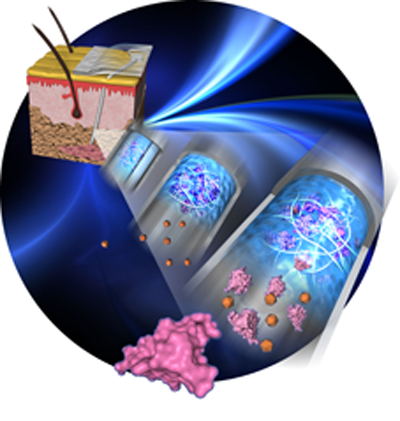
References
- A. Matsumoto et al., Angew. Chem. Int. Ed., 2012, 51(9), 2124. Check,
- B. Beier et al., Sensors, 2011, 11, 409. Check,
- A. Matsumoto et al., Chem. Commun. , 2010, 46, 2203. Check,
Noninvasive Cytology via Determination of Glycan Chain Sialic Acid
Overexpressions of SA have been implicated in the malignant and metastatic phenotypes for many different types of cancers, while decreased SA expression has also been identified in erythrocytes of diabetic mellitus. Techniques to conveniently monitor cell surface SA would therefore have great relevance to cytology. Preexisting methodologies to quantify SA, however, involve multiple enzymatic, dye-labeling and lethal procedures, which are costly and time-consuming. We performeed a potentiometric SA detection using a phenylboronic acid (PBA) compound integrated into the form of self-assembled monolayer (SAM) onto a field effect transistor (FET) extended gold gate electrode. Due to selective binding between undisassociated PBA and SA at pH 7.4 among other glycan chain constituent monosaccharides, we found that carboxyl anions of SA were exclusively detectable as the change in threshold voltage (VT) of the PBA-modified FET. The technique was applied to analyses of altered SA expressions on rabbit erythrocyte and metastatic murine melanoma cells as models for diabetes and metastasis, respectively. Comparative SA expression analyses for each healthy and diseased model revealed that these diseases could be feasibly diagnosed simply by placing the known-count cell suspensions onto the device without any labeling and enzymatic procedures. Such a technique may also provide a quantitative adjunct to histological evaluation of tumor malignancy and metastatic potential during intra- and postoperative diagnoses.
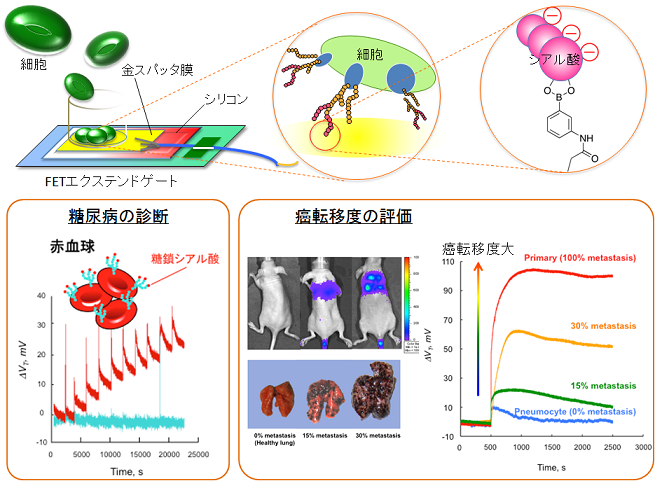
References
- A. Matsumoto et al., Angew. Chem. Int. Ed., 2010, 49, 5494. Check,
- A. Matsumoto et al., J. Am. Chem. Soc., 2009, 131, 12022. Check
- A. Matsumoto et al., Curr. Appl. Phys. 2009, 9, 214. Check
Genetic Analysis using Biotransistors
Extensive research aims to develop a series of biosensors for the detection of DNA recognition events, including DNA sequencing and single-nucleotide polymorphism (SNP) genotyping. In particular, following the completion of the human genome project, strong competition exists for developing a new technology and platform that can sequence a complete human genome for under $1,000. Among the variety of proposed concepts and different types of biosensors that may achieve this goal, the integration of bioactive materials with a semiconductor device is currently recognized as one of the most attractive approaches. The FET-based biosensors provide a significant number of potential advantages such as small size and weight, quick response, label-free detection, low output impedance, on-chip integration of biosensor arrays, low-cost mass production and portable microanalysis. An inherent miniaturization of FET devices and their compatibility with microfabrication processes make them very attractive for integration into microfluidics and micro-analytical devices. SNP genotyping can be achieved by using genetic FETs in combination with the primer extension method or intercalating agents. Also, DNA sequencing can be achieved by using ion-sensitive FET (ISFET) in combination with a stepwise single-base primer extension approach for the first time.
References- T. Sakata and Y. Miyahara, Biosens. Bioelectron., 2007, 22, 1311. Check
- T. Sakata et al., Langmuir, 2007, 23, 2269. Check
- T. Sakata and Y. Miyahara, Angew. Chem. Int. Edn., 2006, 45, 2225. Check
- T. Sakata and Y. Miyahara, Biosens. Bioelectron., 2005, 21, 827. Check
- T. Sakata and Y. Miyahara, ChemBioChem, 2005, 6, 703. Check
- T. Sakata et al., Japanese Journal of Applied Physics, 2005, 44, 2854. Check
- T. Sakata et al., Materials Science and Engineering C, 2004, 24, 827. Check
Projects
12. Grant-in-Aid for Encouragement of Young Scientists from Nakatani Foundation
- Title: Development of minimally-invasive and simplified devices for cancer diagnosis by exosome-sensing
- Duration:2014-2015
- Representor:Miyuki Tabata
11. Grant-in-Aid for Challenging Exploratory Research
- Title: Developing totally synthetic 'artificial pancreas' by smart gels
- Duration:2013-2015
- Representor:Akira Matsumoto
10. JSPS Grant-in-Aid for Young Scientists (B)
- Title: Development of functional interface for long-base sequencing using highly sensitive genetic transistor
- Duration:2013-2016
- Representor:Mai Sanjoh
9. JSPS Grant-in-Aid for Young Scientists (B)
- Title:Monitoring dynamics of cytoskelton proteins by highly sensitive potentiometric biosensors
- Duration:2013-2016
- Representor: Yasuhiro Maeda
8. Grant-in-Aid for Scientific Research on Innovative Areas (MEXT), "Nanomedicine Molecular Science", Publicly offered project
- Title:Evaluating nanocytotoxicity and nanomedicine using ISFET
- Duration:2012-2014
- Representor:Tatsuro Goda
- Link
7. JSPS Bilateral Program, TMDU & Nanyang Tech Univ
- Title: Simultaneous Detection of Multiple DNA Targets on Paramagnetic Beads Packed in Microfluidic Channels using Quantum Dots as Tracers
- Duration: 2012-2014
- Leader: T. Goda & M. Pumera
- Link
6. Strategic Young Researcher Overseas Visits Program for Accelerating Brain Circulation, TMDU & Karolinska Institutet
- Title: Fostering international young leaders in the interdisciplinary area between medical/dental science and engineering through collaboration research on bacterial infections
- Duration: 2011-2014
- Leader: Y. Miyahara & A. Richter-Dahlfors
- Link
5. JSPS Grant-in-Aid for Young Scientists (B)
- Title: Detection of Tumor Biomarkers using Nucleic Acid Aptamer-based Potentiometric Biosensors
- Duration: 2011-2014
- Leader: T. Goda
- Link
4. JSPS Grant-in-Aid for Young Scientists (A)
- Title: Development of an Integrated Transistor that Monitors Enzymatic Activities for Next-generation Analysis of Apoptosis Pathways
- Duration: 2011-2014
- Leader: A. Matsumoto
- Link
3. Funding Program for World-Leading Innovative R & D on Science and Technology (FIRST program)
- Title: Development of Innovative Diagnostics and Therapeutic Systems Based on Nanobiotechnology: Creation of nano-diagnosis system
- Duration: 2011-2014
- Core Researcher: K. Kataoka (University of Tokyo); Co-Core Researcher: Y. Miyahara
- Link
2. Grant-in-Aid for Scientific Research on Innovative Areas (MEXT)
- Title: Soft-Interface Science
- Duration: 2008-2013
- Leader: M. Maeda (RIKEN); Co-Researcher: Y. Miyahara
- Link
- References:
1. Core Research for Evolutional Science & Technology (JST-CREST)
- Title: Creation of Nanosystems with Novel Function through Process Integration
- Duration: 2008-2013
- Supervisor: J. Sone (NIMS); Research Director: Y. Miyahara
- Link
- References:
- D. F. Schaffhauser et al., PLoS ONE, 2012, 7(7), e39238. Check


